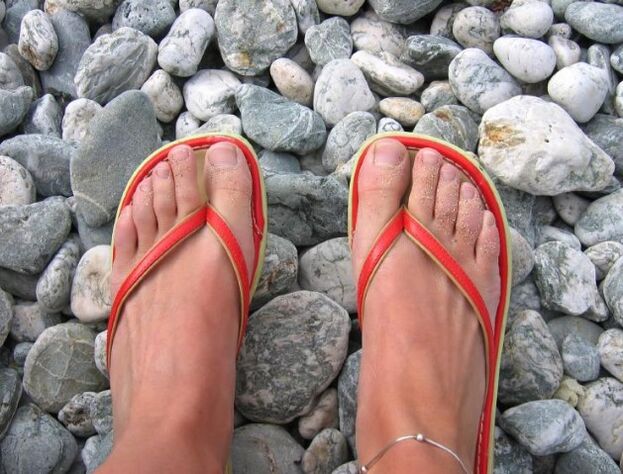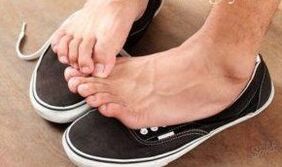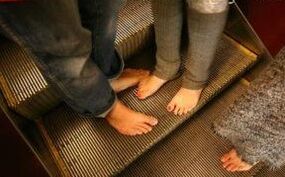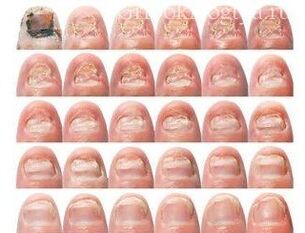Nail fungi are a rather dangerous phenomenon that can progress and damage the entire nail plate. In the early stages of development, the fungus can’t see the eyes, but its negative effects on the structure of the nail plate are intensifying every day. In the stage of the disease, how we will identify our nail fungus and how we treat it, we will analyze further.

There are many signs that help determine the presence of fungal lesions on the nail plate:
- Looseness of nails - You can check it when cutting the edges of your nails. If during this process, nails collapse rather than cut, then this is the first symptom of the existence of fungi and a clear occasion for seeing a doctor.
- The thickening of the nail plate is mainly due to the harmful effects of fungi that can destroy the integrity of nail fibers, which is why the latter changes in qualitative and quantitative forms.
- Nails and their scratches that cut under the skin - This phenomenon not only induces tightening of shoes, but also causes fungal lesions that modify the nail plate, thus providing the wrong location.
- Changes in the color of the nails (from light yellow to brown) - occurs due to the destruction of the active components of the nail board and the folding of protein cells occurs during the destruction.
- The presence of white patches - Fungal spores penetrate deep into the roots of the nails and also appear on the surface, which is dangerous for widespread infections of all toes.
The first sign of problems caused by loss of nails and active mushroom activity is:
- Loss of gloss and surface gloss;
- Nails are slightly yellowed;
- The appearance of the red dots filled with transparent liquid;
- The unpleasant smell of legs, especially after sweating;
- Wear the skin on high heels and soles, and concentrate.
These symptoms indicate various problems in the legs, so it is best not to ignore the doctor's consultation. Early diagnosis greatly facilitates the treatment process, thus ensuring full recovery.

Healthy legs on the legs: norms and deviations
To rule out or determine the presence of fungal diseases, you need to check your legs, fingers, and nails. The following indicators should be maintained:
- The legs are smooth and have no corn, corn and seals.
- The skin of the legs is even, without cracks or spots.
- No redness and itching, especially between fingers.
- The nail plates are flat, plain, and transparent.
- Nail bed, with a glossy surface that is very obvious.
If there is a deviation from the stated criteria and the legs have an unpleasant odor, doctor's consultation and investigation of the presence of the pathogen.
Risk factors for fungi development on legs
Fungal infections can occur anywhere, including household slippers. So, this happens enough:
- Weak immunity cannot limit the active reproduction of mushrooms;
- Sweat in the legs increased due to improper selection and poor quality shoes;
- The cutting of the nail or cuticle is unsuccessful, and there is a cutting in the nail area;
- foot hygiene and insufficient shoes;
- Frequently visit public places with high risk of infection: city bathrooms, saunas, solariums, swimming pools, local beaches;
- Overuse of cosmetics (varnish, nail extensions, refreshing sprays and leg gels) can lead to local immune death.
The individual types of mushrooms have different potential periods during which the disease does not show up.
You can infect fungi in two ways:
- Contact - Direct contact through patients to healthy people: personal hygiene items, public places, wearing other people's shoes.
- Contact - Infection is due to the positive development of those mushrooms in everyone's body. In some cases (e. g. , a sharp decline in immunity), their number increases and they cannot control the body independently.
In most cases, the following categories of people are subject to fungal lesions:
- Children with thinner skin;
- people with HIV infection;
- As your feet sweat increases;
- There are chronic diseases that inhibit the immune system.

If the above indicators are present, you need to carefully monitor the nail condition on your legs and stop them as a whole to pay attention to hygiene.
Differences between fungal nail disease
In medicine, the concept of "fungal damage to nails" is collective, as various mushrooms can act as pathogens. Most of the time, this mushroom is found on the nails of the legs:
- Skin Plants - A group of mushrooms manifested in the form of yellow spots or white vertical stripes. The infected nails gradually lose strength and shape, and after that, the cavity becomes lifeless and easily removed from the nail bed.
- Yeast lesions - Caused by the activity of Candida mushrooms. The nails themselves are thinner, and the side roller blush and swell. It can manifest as a separate disease with frequent persistent colds and weak immunity.
- The mold is mainly located on the surface of the nail, changing its color to a hue of green, brown or white.
It is impossible to determine the cause of fungal disease by yourself, because the same fungi will manifest in different ways when exposed to various general factors. Therefore, it is impossible to start treatment because each mushroom has its own antifungal drugs, which adversely affects the life of the pathogen. Therefore, when the slightest deviation from the norm is diagnosed, you need to consult a doctor and test the presence of the fungus.
Stages of fungal damage in the legs
The process from the moment of infection to the complete destruction of the nail board is called the stage of the disease process. Select them 5:
- Infection - Fungus enters the surface of the nail, passing through the cuticle and into the nail bed.
- Incubation period (from 3 days to 5 months) - Mushrooms are very small in activity, but when all conditions are created for this it is enhanced at lightning speed: weakened immunity, humid heat medium, no proper sanitation. Externally, the incubation period is not manifested in any way.
- Initial Stage - The mushroom is so large that it can negatively affect the feasibility of the nails. The edge of the nail plate gradually changes from the edge to the yellow nail bed. Nails get matte shades, pink healthy colors disappear and gloss disappear from the surface. In this case, notice the dry skin of the toes.
- Phase of the activity process - The mushroom population reaches its maximum, which allows you to gain controversy through contact and can infect other nail plates. Under the influence of fungal activity, the enhancement of high venomous diseases - the production of keratin fibers increases. In this case, the nails are compacted and bulged significantly above the surface of the finger.
- Final stage - murdered nails by not only the lesions of nails, but also the nearby soft tissue. The entire surface of the nail is shaded in yellow or brown, sliced with a feeling of pain.
If there is a large-scale infection, local symptoms may also be added:
- malnutrition in the form of fecal disorders;
- Body temperature rises;
- Leg pain, which is aggravated during exercise;
- Plea link.
All of the above manifestations help to fully determine the stage of myomycosis course. To identify pathogens, you will have to perform special analysis to indicate the exact genus and the type of fungus that triggers the tumor.
How and how to treat

You need to understand that the key to successful treatment is the right diagnosis, which is impossible to do at home. Only doctors based on the analysis results can identify the genus of mushrooms and choose appropriate treatments.
For many, this remains a mystery why antifungal drugs purchased at pharmacies don't help. For this reason, there are many reasons and explanations. First, antifungal drugs are initially selected based on the generator. Second, the treatment of fungi is a complex event, including:
- Topical treatment - Apply antifungal drugs to the nail surface.
- Oral antifungal tablets can inhibit the development of fungi and reduce their number from within.
- Immunostimulatory drugs "force" the body to produce enough immune vehicles to fight fungi independently.
- Observe foot hygiene - Wash your legs 2-3 times a day with cold water and soap and dry with a towel. Cut your nails every 3-5 days.
- Wear shoes made of real leather and cotton linen.
Excluding at least one of these 5 points, the recovery process will be delayed for several months and may not be successful. Only a comprehensive treatment will allow you to completely get rid of the fungus and rule out the risk of recurrence manifestations.
In most cases, traditional medical recipes that are difficult to cure nail fungi are ineffective. The results will only occur if the above recommendations for nail fungal lesions are added.
Therefore, it is not difficult to determine the presence of fungi on the nails on the legs. Generally speaking, it is sufficient to examine the nail plate and all fingers, comparing them to pictures that indicate the presence of fungi. Only when treatment is performed under the control of an expert, it is effective and correct only when treatment is performed. Self-assays can have many negative consequences for health and complicate further treatment of the disease.
















